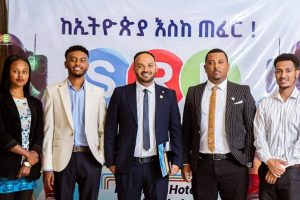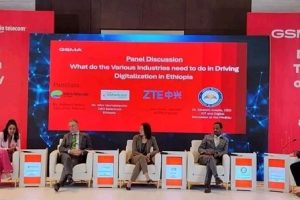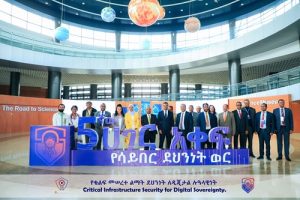BY DARGIE KAHSAY
Ethiopia celebrates the launching of the third year of its first ever satellite, ETRSS-1, to the space. On 20 December 2019, Ethiopia launched its first remote sensing satellite to the space named ETRSS-1 and marked December 20 as Ethiopia’s Space Science Day. The day is commemorated annually in Ethiopia and used to create awareness about the space science sector for the people especially the younger generation.
ETRSS-1 makes Ethiopia the 70th country in the world and the tenth country in Africa to launch a satellite to the space and own a satellite. The 70 kilogram ETRSS-1 is a civil earth observation satellite aimed to provide data for government and research institutions to monitor the environment. In addition, it was aimed to help weather pattern predictions for agricultural production, to develop drought early warning mechanism, to conduct forestry management and to manage mining activities by using the information gained from the satellite.
The satellite was launched after it was developed by 21 Ethiopian scientists in collaboration with China Academy of Space Technology based on the agreement between the governments of Ethiopia and China. After the satellite was launched, the control, operation and maintenance activities were fully operated by Ethiopian experts in the sector based in Entoto Observatory and Space Science Research Center, found near in Addis Ababa.
Space Science and Geospatial Institute of Ethiopia this week commemorated space day and the third year anniversary of the launching of ETRSS-1 with the motto of “Thank You ETRSS-1”. Similarly, the institute also celebrated the annual Geographic Information System (GIS) day parallel to the space science event.
Speaking at the opening session of the twin events, Space Science and Geospatial Institute (SSGI) Director General, Abdisa Yilma stated that ETRSS-1 was launched three years ago with the plan of providing the planned service for two and half years. Abdisa added that though the satellite was sent to the space to provide service for 30 months, beyond the planed period, the satellite is continuing its usual operation and providing services even after six months of the target plan.
The Director General stated that ETRSS-1 laydown a milestone and became an eye-opener in Ethiopia’s space science sector. It contributes and continues contributing a lot in technology transfer and in creating capable and skilled human resource in the sector. In addition, the service it provides also helps the country’s economy in many ways. “ETRSS-1 has special contribution in the Ethiopian space science sector, as Explorer-1 to U.S.A, Sputnik-1 to Russia and Dang Fang Hong-1 to China, ETRSS-1 is the first historic satellite to Ethiopia. The satellite is an eye-opener in the space science sector and plays a great role in image building in addition to its economic benefits,” Abdisa stated.
ETRSS-1 stimulates the space science sector development in Ethiopia. Beyond the services it provides, the parallel benefits of the satellite especially in creating capable manpower in the space sector is very crucial. The experience Ethiopian scientists’ gain from ETRSS-1 is helpful to develop the country’s space science sector. It helps to develop satellite design, operation and maintenance for Ethiopian experts and to prepare for ETRSS-2, he noted.
“Originally, the major duty of ETRSS-1wass gathering information and delivering the gathered data to the center; it achieved a lot in this regard,” Abdisa stated, adding that “based on the information received from ETRSS-1, different applications were developed to find solutions to modernize things.” For him, the information delivered by ETRSS-1 was helpful for agriculture, for water resource management application development, for tourism sector and other activities. In addition, the raw data played significant role for higher institution researchers in different fields.
“So far, based on the information gained from ETRSS-1, different applications were launched and started functioning especially in tourism and water resource management. Recently, we launched ‘Visit Ethiopia’ application jointly with Ministry of Tourism to promote the tourist sites easily through application. Similarly, a mobile application was developed and launched to promote the South Omo and Gamo tourism sites and memorandum of understanding was signed between SSGI and Gamo Zone tourism office,” the director general reiterated.
Similarly, the information from ETRSS-1 was used in the Grand Ethiopian Renaissance Dam (GERD) during the water reservation and in cleaning the forest to prepare the land for the reservoir. It helped to identify and predict the level of the land the water would cover after the filling.
Hence, for Abdisa, the data received from ETRSS-1 was used to agriculture, urban development, road works, land resource management, water resource management, forest protection and tourism sector. The satellite also contributes in supporting the geospatial industry in exploring, discovering and accessing geographic information system (GIS).
During the last three years, Ethiopian space science experts have kept the the satellite’s health and they are operating it successfully. “This experience helped us to develop satellite designs and to start preparations for ETRSS-2,” Abdisa noted adding that “for all these multidimensional services, we thank ETRSS-1 during its third year launching commemoration.”
On her part, Innovation and Technology State Minister, Huria Ali stated that science, technology and innovation are becoming priority sectors of the government to realize the country’s comprehensive prosperity. As to her, space science would play irreplaceable role in supporting the journey to prosperity by supporting every sector in developing new applications to modernize services.
Following the 2018 reform, Ethiopia accords due attention to science, technology and new innovations so as to modernize all sectors. The historic remote sensing satellite, ETRSS-1 launched a year after the reform and the space science sector are stimulated following this development.
As to the state minister, as Ethiopia is striving to modernize its services using the information communication technology (ICT), the space science is crucial in supporting and accelerating the country’s development journey. In this regard, ETRSS-1 becomes an eye-opener in the sector, she added.
“Ethiopia launches National Digital Transformation Strategy to transform the digital sector which is also critical to transform the overall economy and service provision,” Huria noted. She added that investing in science and technology would accelerate Ethiopia’s journey to prosperity. Ethiopia has a vision of joining the ranks of the economically prosperous African countries, Huria stated adding that to realize this vision, it is critical to exploit the comparative advantage Ethiopia has in all sectors.
As to her, the space science sector is not a luxury investment; the sector plays a crucial role in accelerating the fight against poverty and helps the journey towards development and prosperity. “Though Ethiopia joined the space sector lately, we have to use the latecomers advantage to develop our presence in the space and to exploit the benefits from the space science sector,” the state minister stressed.
Majority of the Ethiopian population comprises youths who can easily understand new technologies and the developments of science. Hence, it is important to promote and support the efforts and innovations in science and technology sectors. Ethiopia is home to high youth population and as latecomers to join the space science sector which gives an opportunity to learn from others, it is important to accelerate the development of the space science sector. To develop the space science sector, in addition to its economic contribution, the experience from ETRSS-1 would help to accelerate the sector’s development journey.
Entoto Observatory and Space Science Research Center is playing a great role in developing Ethiopia’s space science sector. Especially, following the launch of ETRSS-1, the sector attracts the younger generation and innovational activities are stimulated across schools and research centers.
THE ETHIOPIAN HERALD FRIDAY 30 DECEMBER 2022





